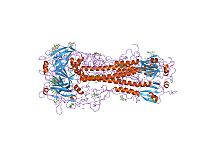
Photo from wikipedia
Influenza hemagglutinin is the fusion protein that mediates fusion of the viral and host membranes through a large conformational change upon acidification in the developing endosome. The "spring-loaded" model has… Click to show full abstract
Influenza hemagglutinin is the fusion protein that mediates fusion of the viral and host membranes through a large conformational change upon acidification in the developing endosome. The "spring-loaded" model has long been used to describe the mechanism of hemagglutinin and other type 1 viral glycoproteins. This model postulates a metastable conformation of the HA2 subunit, caged from adopting a lower-free energy conformation by the HA1 subunit. Here, using a combination of biochemical and spectroscopic methods, we study a truncated construct of HA2 (HA2*, lacking the transmembrane domain) recombinantly expressed in Escherichia coli as a model for HA2 without the influence of HA1. Our data show that HA2* folds into a conformation like that of HA2 in full length HA and forms trimers. Upon acidification, HA2* undergoes a conformational change that is consistent with the change from pre- to postfusion HA2 in HA. This conformational change is fast and occurs on a time scale that is not consistent with aggregation. These results suggest that the prefusion conformation of HA2 is stable and the change to the postfusion conformation is due to protonation of HA2 itself and not merely uncaging by HA1.
Journal Title: Biochemistry
Year Published: 2021
Link to full text (if available)
Share on Social Media: Sign Up to like & get
recommendations!